MGT703: IBM's Corporate Level Strategy Analysis - Semester 1 Report
VerifiedAdded on 2023/03/30
|19
|4499
|134
Report
AI Summary
This report provides a detailed analysis of IBM's corporate-level strategy, examining its approach to governance, social responsibility, ethics, and stakeholder theory. The report explores IBM's corporate level strategies including horizontal and vertical integration, cooperative relationships, and diversification. It also delves into IBM's organizational structure, culture, and performance measurement systems, including the use of a balance scorecard and CSR pyramid. The report assesses IBM's governance practices, corporate social responsibility initiatives, and ethical considerations, highlighting the company's commitment to sustainability and its diverse stakeholder base. The analysis covers the past 3-5 years, offering a comprehensive evaluation of IBM's strategic decisions and their impact on the company's market position and performance. Finally, the report concludes with a set of recommendations aimed at improving IBM's corporate strategy and increasing profitability.

Corporate Level Strategy for IBM
Student Name:
Student ID:
Lecturer’s Name:
Name of the Business:
1
Student Name:
Student ID:
Lecturer’s Name:
Name of the Business:
1
Paraphrase This Document
Need a fresh take? Get an instant paraphrase of this document with our AI Paraphraser
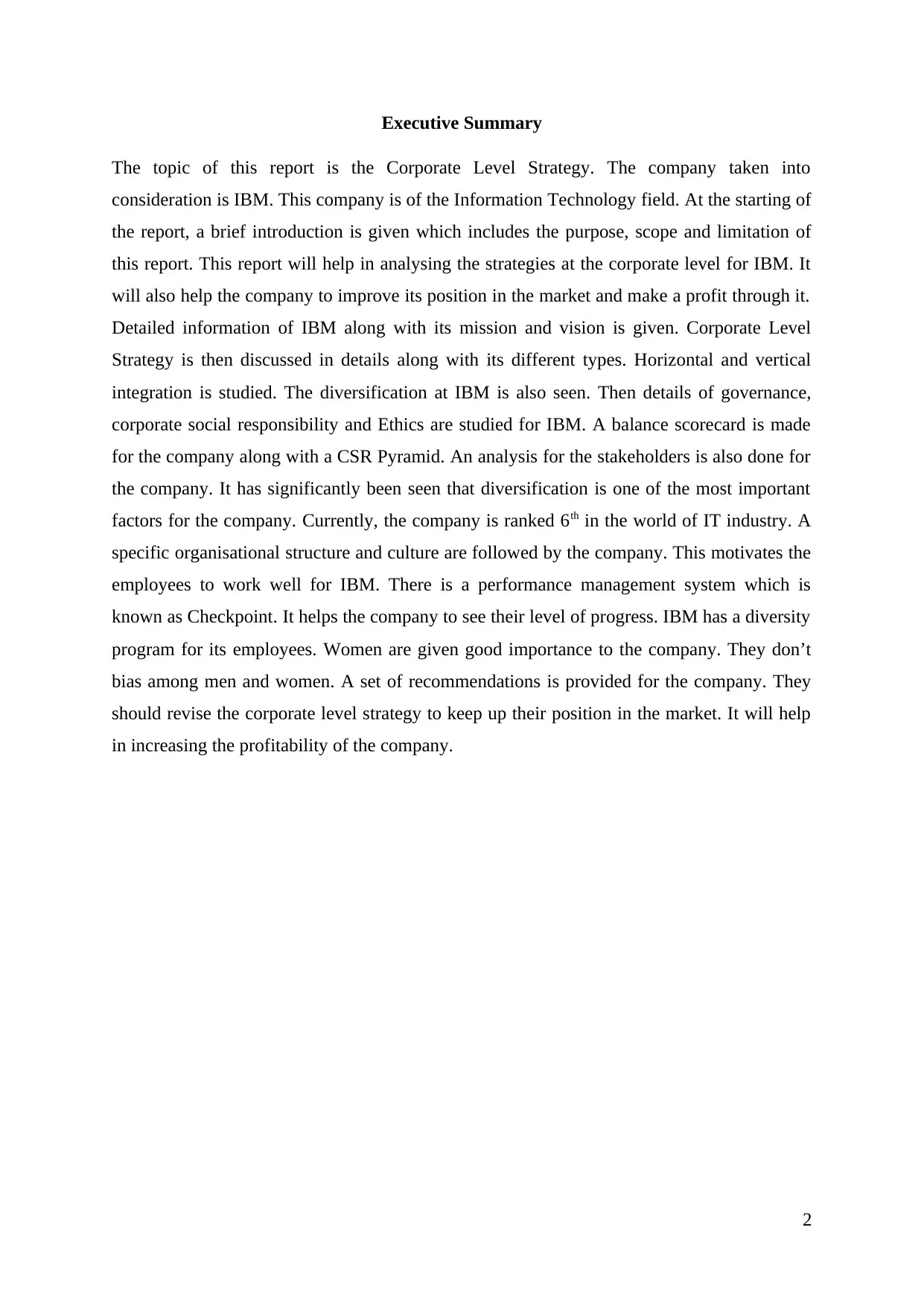
Executive Summary
The topic of this report is the Corporate Level Strategy. The company taken into
consideration is IBM. This company is of the Information Technology field. At the starting of
the report, a brief introduction is given which includes the purpose, scope and limitation of
this report. This report will help in analysing the strategies at the corporate level for IBM. It
will also help the company to improve its position in the market and make a profit through it.
Detailed information of IBM along with its mission and vision is given. Corporate Level
Strategy is then discussed in details along with its different types. Horizontal and vertical
integration is studied. The diversification at IBM is also seen. Then details of governance,
corporate social responsibility and Ethics are studied for IBM. A balance scorecard is made
for the company along with a CSR Pyramid. An analysis for the stakeholders is also done for
the company. It has significantly been seen that diversification is one of the most important
factors for the company. Currently, the company is ranked 6th in the world of IT industry. A
specific organisational structure and culture are followed by the company. This motivates the
employees to work well for IBM. There is a performance management system which is
known as Checkpoint. It helps the company to see their level of progress. IBM has a diversity
program for its employees. Women are given good importance to the company. They don’t
bias among men and women. A set of recommendations is provided for the company. They
should revise the corporate level strategy to keep up their position in the market. It will help
in increasing the profitability of the company.
2
The topic of this report is the Corporate Level Strategy. The company taken into
consideration is IBM. This company is of the Information Technology field. At the starting of
the report, a brief introduction is given which includes the purpose, scope and limitation of
this report. This report will help in analysing the strategies at the corporate level for IBM. It
will also help the company to improve its position in the market and make a profit through it.
Detailed information of IBM along with its mission and vision is given. Corporate Level
Strategy is then discussed in details along with its different types. Horizontal and vertical
integration is studied. The diversification at IBM is also seen. Then details of governance,
corporate social responsibility and Ethics are studied for IBM. A balance scorecard is made
for the company along with a CSR Pyramid. An analysis for the stakeholders is also done for
the company. It has significantly been seen that diversification is one of the most important
factors for the company. Currently, the company is ranked 6th in the world of IT industry. A
specific organisational structure and culture are followed by the company. This motivates the
employees to work well for IBM. There is a performance management system which is
known as Checkpoint. It helps the company to see their level of progress. IBM has a diversity
program for its employees. Women are given good importance to the company. They don’t
bias among men and women. A set of recommendations is provided for the company. They
should revise the corporate level strategy to keep up their position in the market. It will help
in increasing the profitability of the company.
2
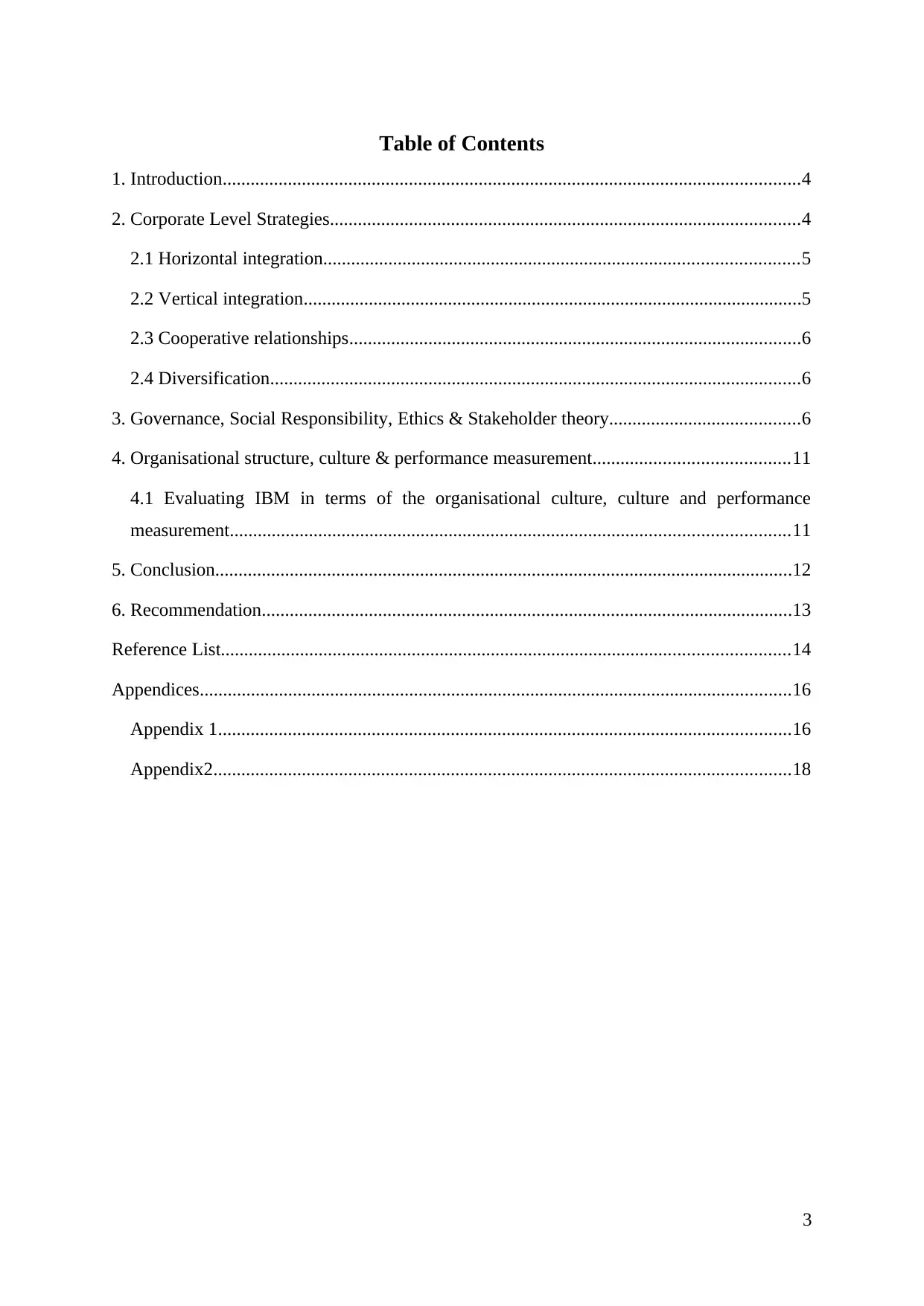
Table of Contents
1. Introduction............................................................................................................................4
2. Corporate Level Strategies.....................................................................................................4
2.1 Horizontal integration......................................................................................................5
2.2 Vertical integration...........................................................................................................5
2.3 Cooperative relationships.................................................................................................6
2.4 Diversification..................................................................................................................6
3. Governance, Social Responsibility, Ethics & Stakeholder theory.........................................6
4. Organisational structure, culture & performance measurement..........................................11
4.1 Evaluating IBM in terms of the organisational culture, culture and performance
measurement........................................................................................................................11
5. Conclusion............................................................................................................................12
6. Recommendation..................................................................................................................13
Reference List..........................................................................................................................14
Appendices...............................................................................................................................16
Appendix 1...........................................................................................................................16
Appendix2............................................................................................................................18
3
1. Introduction............................................................................................................................4
2. Corporate Level Strategies.....................................................................................................4
2.1 Horizontal integration......................................................................................................5
2.2 Vertical integration...........................................................................................................5
2.3 Cooperative relationships.................................................................................................6
2.4 Diversification..................................................................................................................6
3. Governance, Social Responsibility, Ethics & Stakeholder theory.........................................6
4. Organisational structure, culture & performance measurement..........................................11
4.1 Evaluating IBM in terms of the organisational culture, culture and performance
measurement........................................................................................................................11
5. Conclusion............................................................................................................................12
6. Recommendation..................................................................................................................13
Reference List..........................................................................................................................14
Appendices...............................................................................................................................16
Appendix 1...........................................................................................................................16
Appendix2............................................................................................................................18
3
⊘ This is a preview!⊘
Do you want full access?
Subscribe today to unlock all pages.

Trusted by 1+ million students worldwide
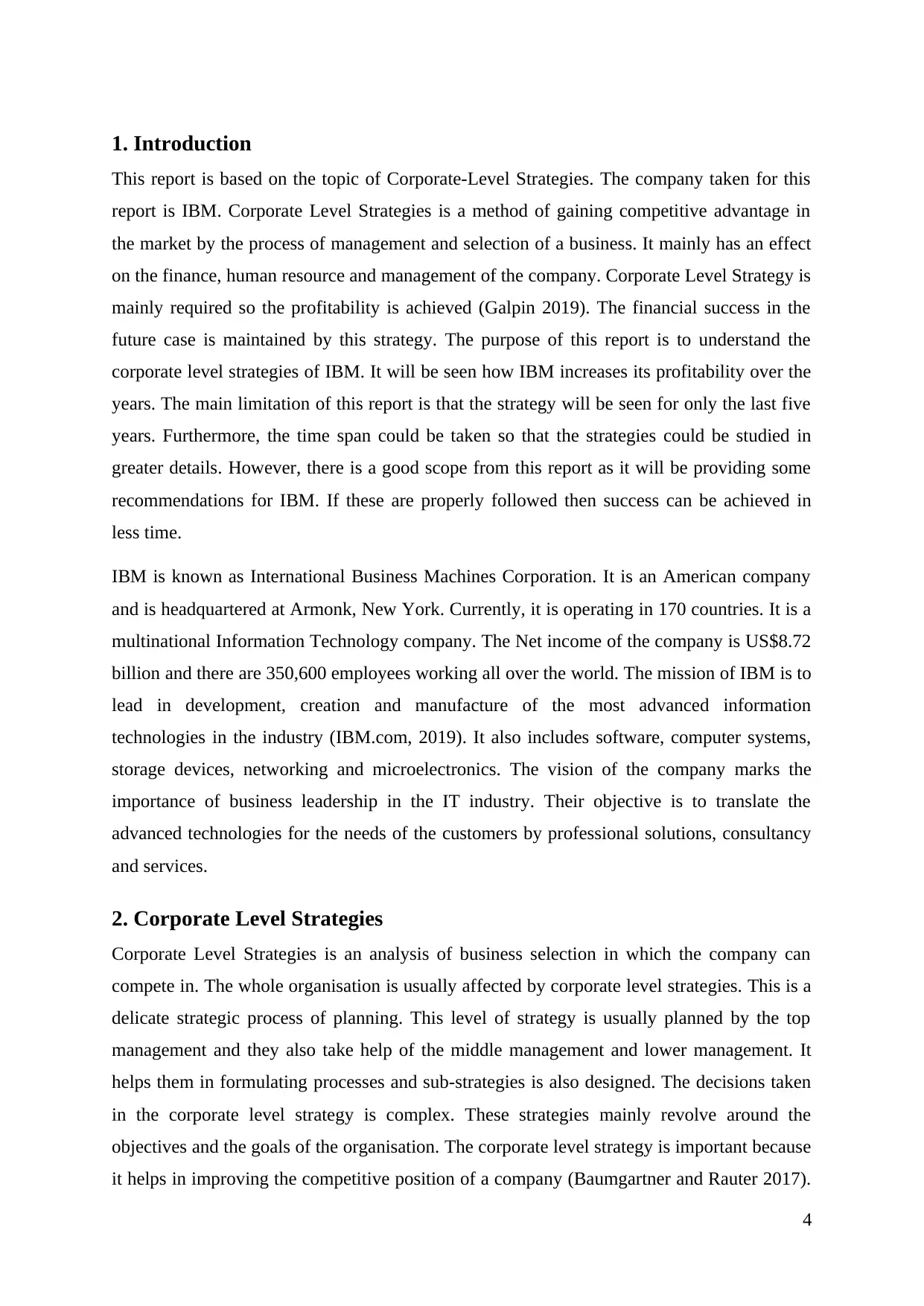
1. Introduction
This report is based on the topic of Corporate-Level Strategies. The company taken for this
report is IBM. Corporate Level Strategies is a method of gaining competitive advantage in
the market by the process of management and selection of a business. It mainly has an effect
on the finance, human resource and management of the company. Corporate Level Strategy is
mainly required so the profitability is achieved (Galpin 2019). The financial success in the
future case is maintained by this strategy. The purpose of this report is to understand the
corporate level strategies of IBM. It will be seen how IBM increases its profitability over the
years. The main limitation of this report is that the strategy will be seen for only the last five
years. Furthermore, the time span could be taken so that the strategies could be studied in
greater details. However, there is a good scope from this report as it will be providing some
recommendations for IBM. If these are properly followed then success can be achieved in
less time.
IBM is known as International Business Machines Corporation. It is an American company
and is headquartered at Armonk, New York. Currently, it is operating in 170 countries. It is a
multinational Information Technology company. The Net income of the company is US$8.72
billion and there are 350,600 employees working all over the world. The mission of IBM is to
lead in development, creation and manufacture of the most advanced information
technologies in the industry (IBM.com, 2019). It also includes software, computer systems,
storage devices, networking and microelectronics. The vision of the company marks the
importance of business leadership in the IT industry. Their objective is to translate the
advanced technologies for the needs of the customers by professional solutions, consultancy
and services.
2. Corporate Level Strategies
Corporate Level Strategies is an analysis of business selection in which the company can
compete in. The whole organisation is usually affected by corporate level strategies. This is a
delicate strategic process of planning. This level of strategy is usually planned by the top
management and they also take help of the middle management and lower management. It
helps them in formulating processes and sub-strategies is also designed. The decisions taken
in the corporate level strategy is complex. These strategies mainly revolve around the
objectives and the goals of the organisation. The corporate level strategy is important because
it helps in improving the competitive position of a company (Baumgartner and Rauter 2017).
4
This report is based on the topic of Corporate-Level Strategies. The company taken for this
report is IBM. Corporate Level Strategies is a method of gaining competitive advantage in
the market by the process of management and selection of a business. It mainly has an effect
on the finance, human resource and management of the company. Corporate Level Strategy is
mainly required so the profitability is achieved (Galpin 2019). The financial success in the
future case is maintained by this strategy. The purpose of this report is to understand the
corporate level strategies of IBM. It will be seen how IBM increases its profitability over the
years. The main limitation of this report is that the strategy will be seen for only the last five
years. Furthermore, the time span could be taken so that the strategies could be studied in
greater details. However, there is a good scope from this report as it will be providing some
recommendations for IBM. If these are properly followed then success can be achieved in
less time.
IBM is known as International Business Machines Corporation. It is an American company
and is headquartered at Armonk, New York. Currently, it is operating in 170 countries. It is a
multinational Information Technology company. The Net income of the company is US$8.72
billion and there are 350,600 employees working all over the world. The mission of IBM is to
lead in development, creation and manufacture of the most advanced information
technologies in the industry (IBM.com, 2019). It also includes software, computer systems,
storage devices, networking and microelectronics. The vision of the company marks the
importance of business leadership in the IT industry. Their objective is to translate the
advanced technologies for the needs of the customers by professional solutions, consultancy
and services.
2. Corporate Level Strategies
Corporate Level Strategies is an analysis of business selection in which the company can
compete in. The whole organisation is usually affected by corporate level strategies. This is a
delicate strategic process of planning. This level of strategy is usually planned by the top
management and they also take help of the middle management and lower management. It
helps them in formulating processes and sub-strategies is also designed. The decisions taken
in the corporate level strategy is complex. These strategies mainly revolve around the
objectives and the goals of the organisation. The corporate level strategy is important because
it helps in improving the competitive position of a company (Baumgartner and Rauter 2017).
4
Paraphrase This Document
Need a fresh take? Get an instant paraphrase of this document with our AI Paraphraser
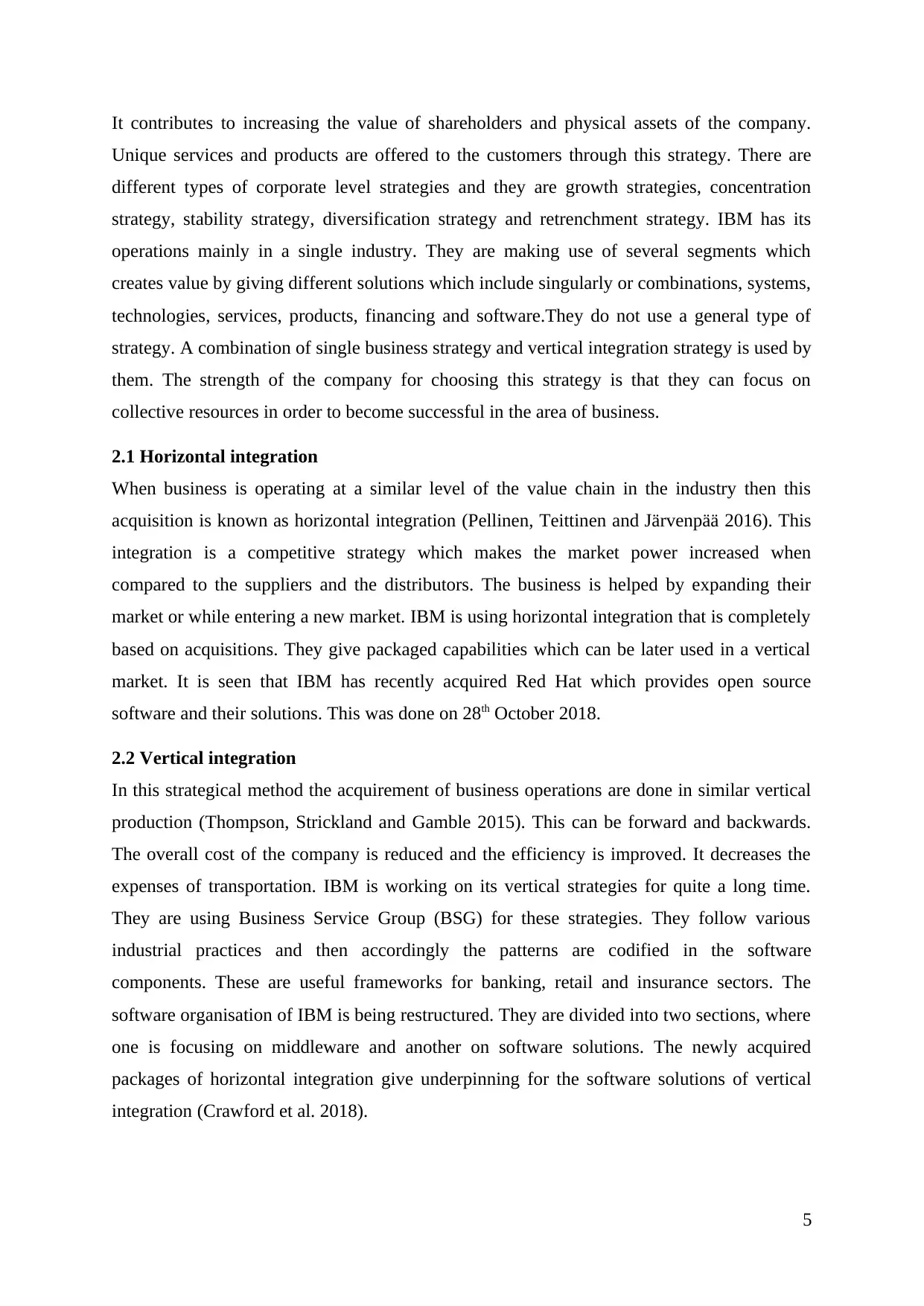
It contributes to increasing the value of shareholders and physical assets of the company.
Unique services and products are offered to the customers through this strategy. There are
different types of corporate level strategies and they are growth strategies, concentration
strategy, stability strategy, diversification strategy and retrenchment strategy. IBM has its
operations mainly in a single industry. They are making use of several segments which
creates value by giving different solutions which include singularly or combinations, systems,
technologies, services, products, financing and software.They do not use a general type of
strategy. A combination of single business strategy and vertical integration strategy is used by
them. The strength of the company for choosing this strategy is that they can focus on
collective resources in order to become successful in the area of business.
2.1 Horizontal integration
When business is operating at a similar level of the value chain in the industry then this
acquisition is known as horizontal integration (Pellinen, Teittinen and Järvenpää 2016). This
integration is a competitive strategy which makes the market power increased when
compared to the suppliers and the distributors. The business is helped by expanding their
market or while entering a new market. IBM is using horizontal integration that is completely
based on acquisitions. They give packaged capabilities which can be later used in a vertical
market. It is seen that IBM has recently acquired Red Hat which provides open source
software and their solutions. This was done on 28th October 2018.
2.2 Vertical integration
In this strategical method the acquirement of business operations are done in similar vertical
production (Thompson, Strickland and Gamble 2015). This can be forward and backwards.
The overall cost of the company is reduced and the efficiency is improved. It decreases the
expenses of transportation. IBM is working on its vertical strategies for quite a long time.
They are using Business Service Group (BSG) for these strategies. They follow various
industrial practices and then accordingly the patterns are codified in the software
components. These are useful frameworks for banking, retail and insurance sectors. The
software organisation of IBM is being restructured. They are divided into two sections, where
one is focusing on middleware and another on software solutions. The newly acquired
packages of horizontal integration give underpinning for the software solutions of vertical
integration (Crawford et al. 2018).
5
Unique services and products are offered to the customers through this strategy. There are
different types of corporate level strategies and they are growth strategies, concentration
strategy, stability strategy, diversification strategy and retrenchment strategy. IBM has its
operations mainly in a single industry. They are making use of several segments which
creates value by giving different solutions which include singularly or combinations, systems,
technologies, services, products, financing and software.They do not use a general type of
strategy. A combination of single business strategy and vertical integration strategy is used by
them. The strength of the company for choosing this strategy is that they can focus on
collective resources in order to become successful in the area of business.
2.1 Horizontal integration
When business is operating at a similar level of the value chain in the industry then this
acquisition is known as horizontal integration (Pellinen, Teittinen and Järvenpää 2016). This
integration is a competitive strategy which makes the market power increased when
compared to the suppliers and the distributors. The business is helped by expanding their
market or while entering a new market. IBM is using horizontal integration that is completely
based on acquisitions. They give packaged capabilities which can be later used in a vertical
market. It is seen that IBM has recently acquired Red Hat which provides open source
software and their solutions. This was done on 28th October 2018.
2.2 Vertical integration
In this strategical method the acquirement of business operations are done in similar vertical
production (Thompson, Strickland and Gamble 2015). This can be forward and backwards.
The overall cost of the company is reduced and the efficiency is improved. It decreases the
expenses of transportation. IBM is working on its vertical strategies for quite a long time.
They are using Business Service Group (BSG) for these strategies. They follow various
industrial practices and then accordingly the patterns are codified in the software
components. These are useful frameworks for banking, retail and insurance sectors. The
software organisation of IBM is being restructured. They are divided into two sections, where
one is focusing on middleware and another on software solutions. The newly acquired
packages of horizontal integration give underpinning for the software solutions of vertical
integration (Crawford et al. 2018).
5
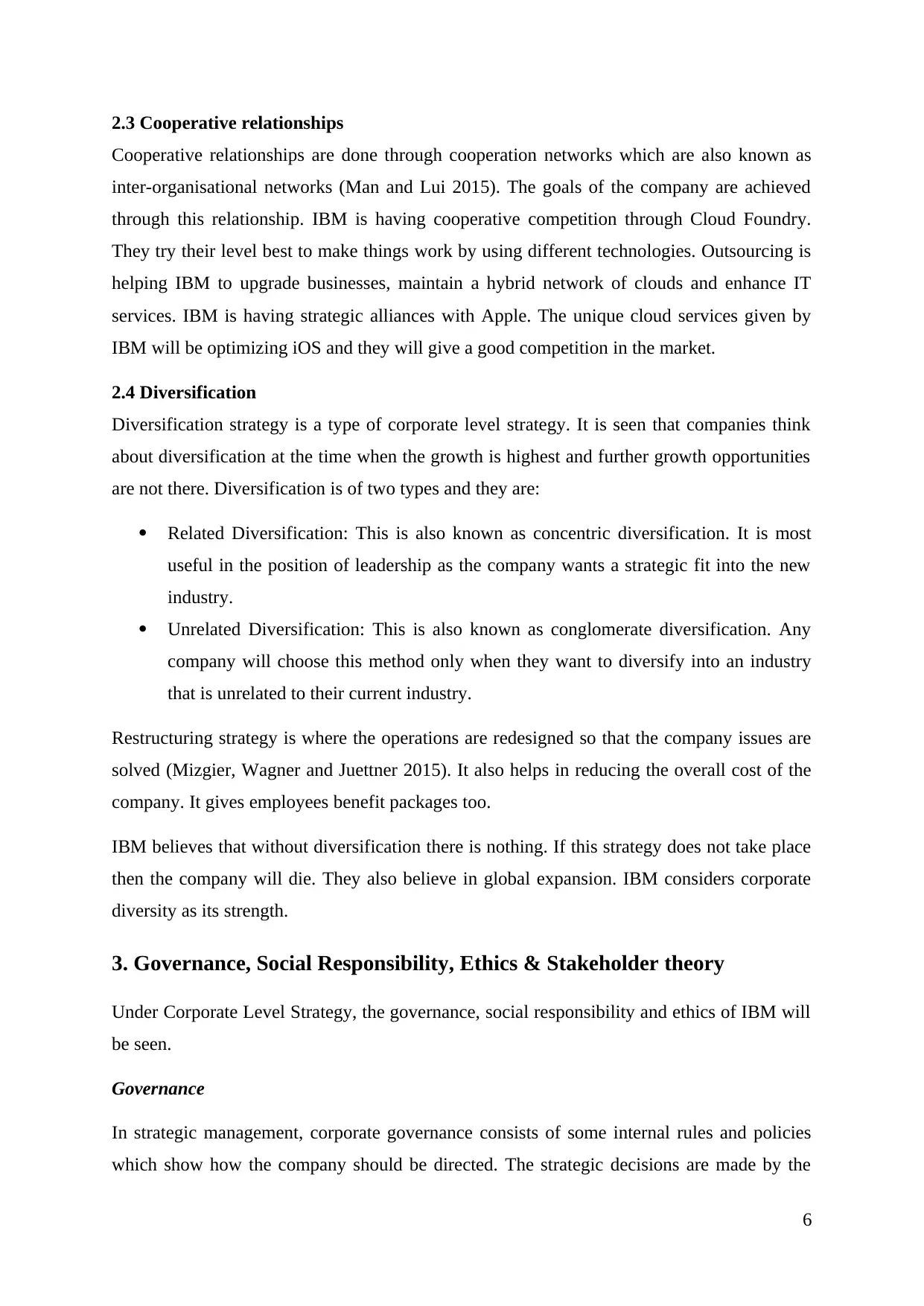
2.3 Cooperative relationships
Cooperative relationships are done through cooperation networks which are also known as
inter-organisational networks (Man and Lui 2015). The goals of the company are achieved
through this relationship. IBM is having cooperative competition through Cloud Foundry.
They try their level best to make things work by using different technologies. Outsourcing is
helping IBM to upgrade businesses, maintain a hybrid network of clouds and enhance IT
services. IBM is having strategic alliances with Apple. The unique cloud services given by
IBM will be optimizing iOS and they will give a good competition in the market.
2.4 Diversification
Diversification strategy is a type of corporate level strategy. It is seen that companies think
about diversification at the time when the growth is highest and further growth opportunities
are not there. Diversification is of two types and they are:
Related Diversification: This is also known as concentric diversification. It is most
useful in the position of leadership as the company wants a strategic fit into the new
industry.
Unrelated Diversification: This is also known as conglomerate diversification. Any
company will choose this method only when they want to diversify into an industry
that is unrelated to their current industry.
Restructuring strategy is where the operations are redesigned so that the company issues are
solved (Mizgier, Wagner and Juettner 2015). It also helps in reducing the overall cost of the
company. It gives employees benefit packages too.
IBM believes that without diversification there is nothing. If this strategy does not take place
then the company will die. They also believe in global expansion. IBM considers corporate
diversity as its strength.
3. Governance, Social Responsibility, Ethics & Stakeholder theory
Under Corporate Level Strategy, the governance, social responsibility and ethics of IBM will
be seen.
Governance
In strategic management, corporate governance consists of some internal rules and policies
which show how the company should be directed. The strategic decisions are made by the
6
Cooperative relationships are done through cooperation networks which are also known as
inter-organisational networks (Man and Lui 2015). The goals of the company are achieved
through this relationship. IBM is having cooperative competition through Cloud Foundry.
They try their level best to make things work by using different technologies. Outsourcing is
helping IBM to upgrade businesses, maintain a hybrid network of clouds and enhance IT
services. IBM is having strategic alliances with Apple. The unique cloud services given by
IBM will be optimizing iOS and they will give a good competition in the market.
2.4 Diversification
Diversification strategy is a type of corporate level strategy. It is seen that companies think
about diversification at the time when the growth is highest and further growth opportunities
are not there. Diversification is of two types and they are:
Related Diversification: This is also known as concentric diversification. It is most
useful in the position of leadership as the company wants a strategic fit into the new
industry.
Unrelated Diversification: This is also known as conglomerate diversification. Any
company will choose this method only when they want to diversify into an industry
that is unrelated to their current industry.
Restructuring strategy is where the operations are redesigned so that the company issues are
solved (Mizgier, Wagner and Juettner 2015). It also helps in reducing the overall cost of the
company. It gives employees benefit packages too.
IBM believes that without diversification there is nothing. If this strategy does not take place
then the company will die. They also believe in global expansion. IBM considers corporate
diversity as its strength.
3. Governance, Social Responsibility, Ethics & Stakeholder theory
Under Corporate Level Strategy, the governance, social responsibility and ethics of IBM will
be seen.
Governance
In strategic management, corporate governance consists of some internal rules and policies
which show how the company should be directed. The strategic decisions are made by the
6
⊘ This is a preview!⊘
Do you want full access?
Subscribe today to unlock all pages.

Trusted by 1+ million students worldwide
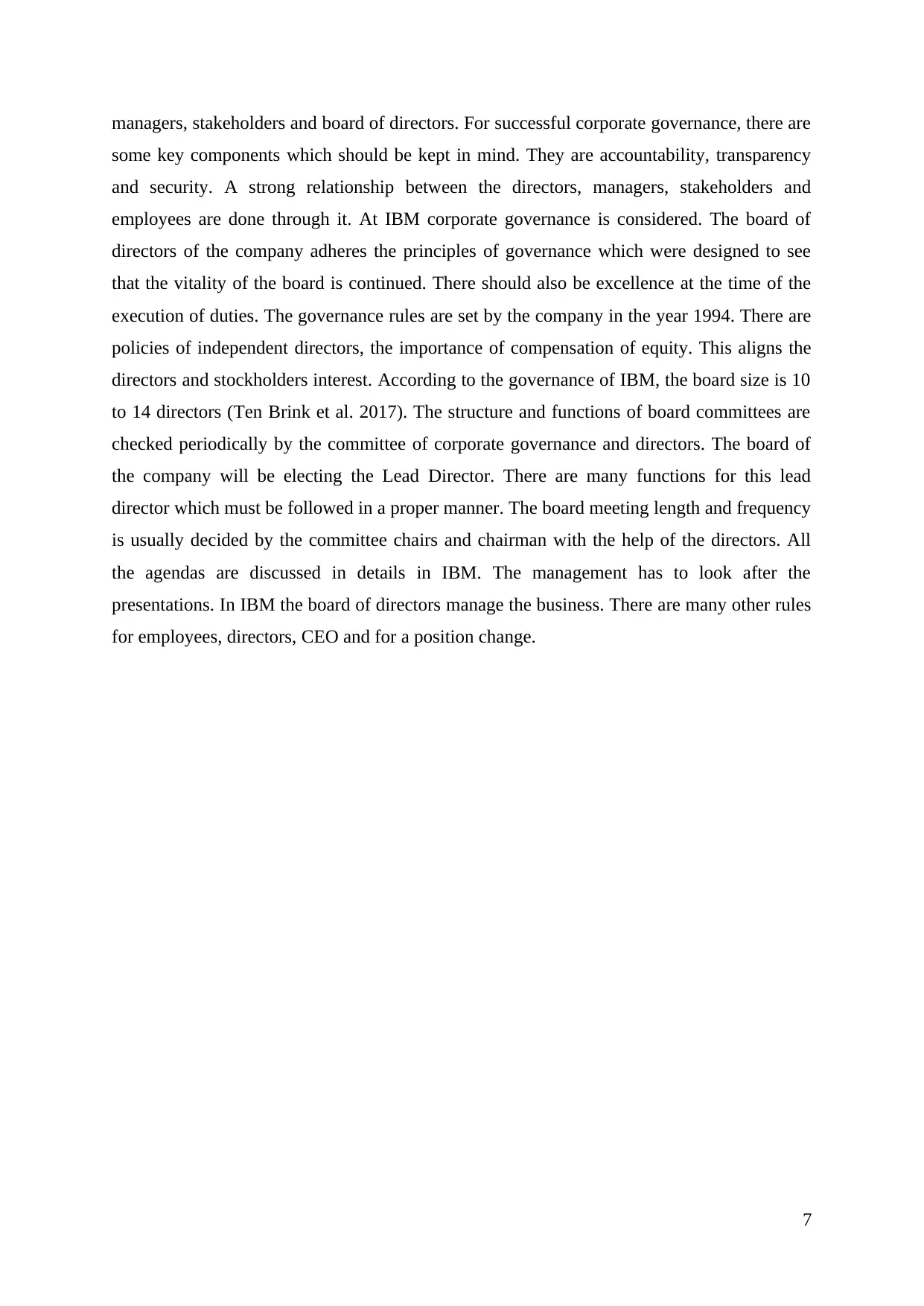
managers, stakeholders and board of directors. For successful corporate governance, there are
some key components which should be kept in mind. They are accountability, transparency
and security. A strong relationship between the directors, managers, stakeholders and
employees are done through it. At IBM corporate governance is considered. The board of
directors of the company adheres the principles of governance which were designed to see
that the vitality of the board is continued. There should also be excellence at the time of the
execution of duties. The governance rules are set by the company in the year 1994. There are
policies of independent directors, the importance of compensation of equity. This aligns the
directors and stockholders interest. According to the governance of IBM, the board size is 10
to 14 directors (Ten Brink et al. 2017). The structure and functions of board committees are
checked periodically by the committee of corporate governance and directors. The board of
the company will be electing the Lead Director. There are many functions for this lead
director which must be followed in a proper manner. The board meeting length and frequency
is usually decided by the committee chairs and chairman with the help of the directors. All
the agendas are discussed in details in IBM. The management has to look after the
presentations. In IBM the board of directors manage the business. There are many other rules
for employees, directors, CEO and for a position change.
7
some key components which should be kept in mind. They are accountability, transparency
and security. A strong relationship between the directors, managers, stakeholders and
employees are done through it. At IBM corporate governance is considered. The board of
directors of the company adheres the principles of governance which were designed to see
that the vitality of the board is continued. There should also be excellence at the time of the
execution of duties. The governance rules are set by the company in the year 1994. There are
policies of independent directors, the importance of compensation of equity. This aligns the
directors and stockholders interest. According to the governance of IBM, the board size is 10
to 14 directors (Ten Brink et al. 2017). The structure and functions of board committees are
checked periodically by the committee of corporate governance and directors. The board of
the company will be electing the Lead Director. There are many functions for this lead
director which must be followed in a proper manner. The board meeting length and frequency
is usually decided by the committee chairs and chairman with the help of the directors. All
the agendas are discussed in details in IBM. The management has to look after the
presentations. In IBM the board of directors manage the business. There are many other rules
for employees, directors, CEO and for a position change.
7
Paraphrase This Document
Need a fresh take? Get an instant paraphrase of this document with our AI Paraphraser
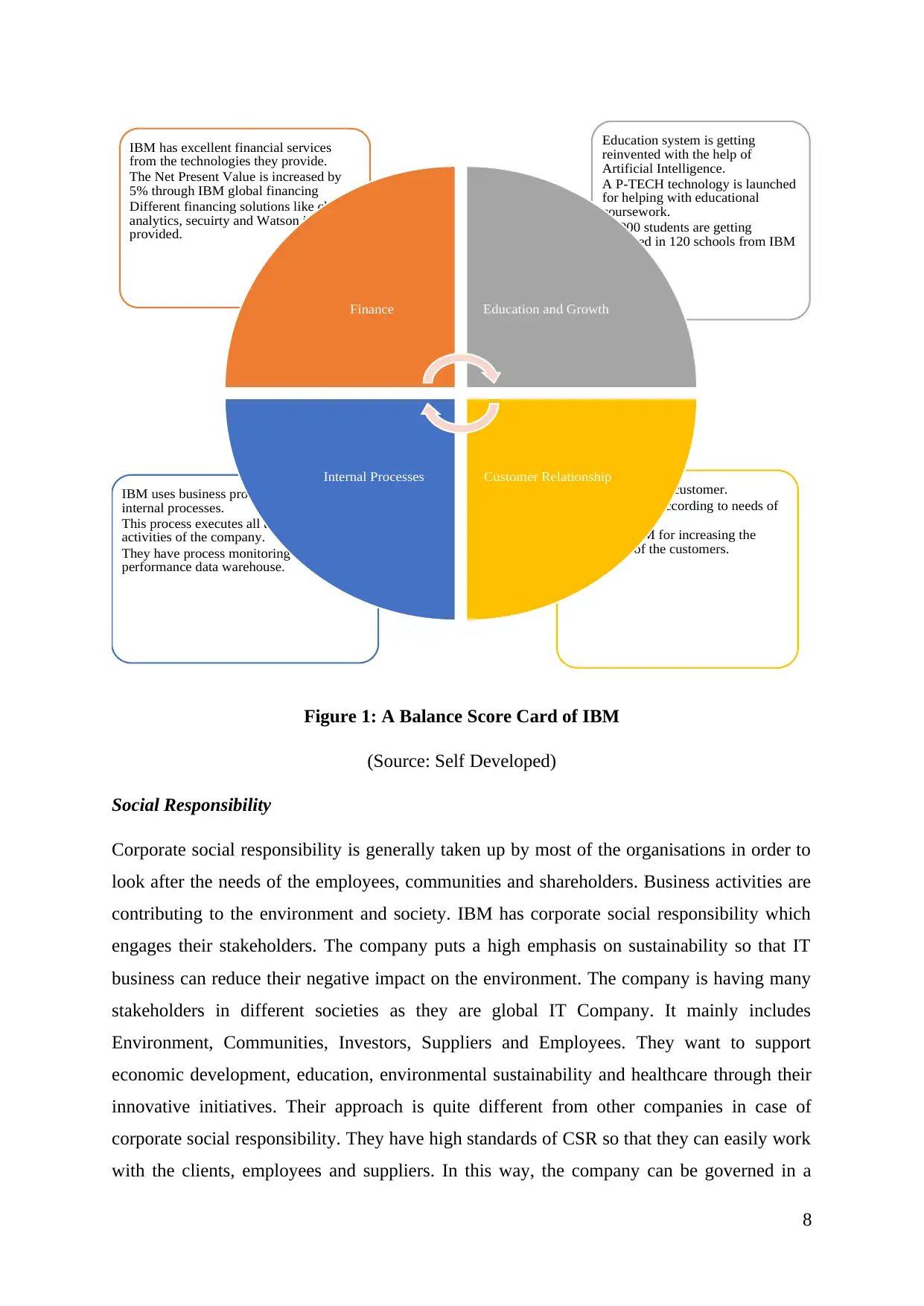
Figure 1: A Balance Score Card of IBM
(Source: Self Developed)
Social Responsibility
Corporate social responsibility is generally taken up by most of the organisations in order to
look after the needs of the employees, communities and shareholders. Business activities are
contributing to the environment and society. IBM has corporate social responsibility which
engages their stakeholders. The company puts a high emphasis on sustainability so that IT
business can reduce their negative impact on the environment. The company is having many
stakeholders in different societies as they are global IT Company. It mainly includes
Environment, Communities, Investors, Suppliers and Employees. They want to support
economic development, education, environmental sustainability and healthcare through their
innovative initiatives. Their approach is quite different from other companies in case of
corporate social responsibility. They have high standards of CSR so that they can easily work
with the clients, employees and suppliers. In this way, the company can be governed in a
8
Highly focused on customer.
Makes products according to needs of
the customers.
IBM uses CRM for increasing the
satisfaction of the customers.
IBM uses business processes for their
internal processes.
This process executes all the objectives and
activities of the company.
They have process monitoring system for
performance data warehouse.
Education system is getting
reinvented with the help of
Artificial Intelligence.
A P-TECH technology is launched
for helping with educational
coursework.
75,000 students are getting
educated in 120 schools from IBM
IBM has excellent financial services
from the technologies they provide.
The Net Present Value is increased by
5% through IBM global financing
Different financing solutions like cloud,
analytics, secuirty and Watson is
provided.
Finance Education and Growth
Customer RelationshipInternal Processes
(Source: Self Developed)
Social Responsibility
Corporate social responsibility is generally taken up by most of the organisations in order to
look after the needs of the employees, communities and shareholders. Business activities are
contributing to the environment and society. IBM has corporate social responsibility which
engages their stakeholders. The company puts a high emphasis on sustainability so that IT
business can reduce their negative impact on the environment. The company is having many
stakeholders in different societies as they are global IT Company. It mainly includes
Environment, Communities, Investors, Suppliers and Employees. They want to support
economic development, education, environmental sustainability and healthcare through their
innovative initiatives. Their approach is quite different from other companies in case of
corporate social responsibility. They have high standards of CSR so that they can easily work
with the clients, employees and suppliers. In this way, the company can be governed in a
8
Highly focused on customer.
Makes products according to needs of
the customers.
IBM uses CRM for increasing the
satisfaction of the customers.
IBM uses business processes for their
internal processes.
This process executes all the objectives and
activities of the company.
They have process monitoring system for
performance data warehouse.
Education system is getting
reinvented with the help of
Artificial Intelligence.
A P-TECH technology is launched
for helping with educational
coursework.
75,000 students are getting
educated in 120 schools from IBM
IBM has excellent financial services
from the technologies they provide.
The Net Present Value is increased by
5% through IBM global financing
Different financing solutions like cloud,
analytics, secuirty and Watson is
provided.
Finance Education and Growth
Customer RelationshipInternal Processes
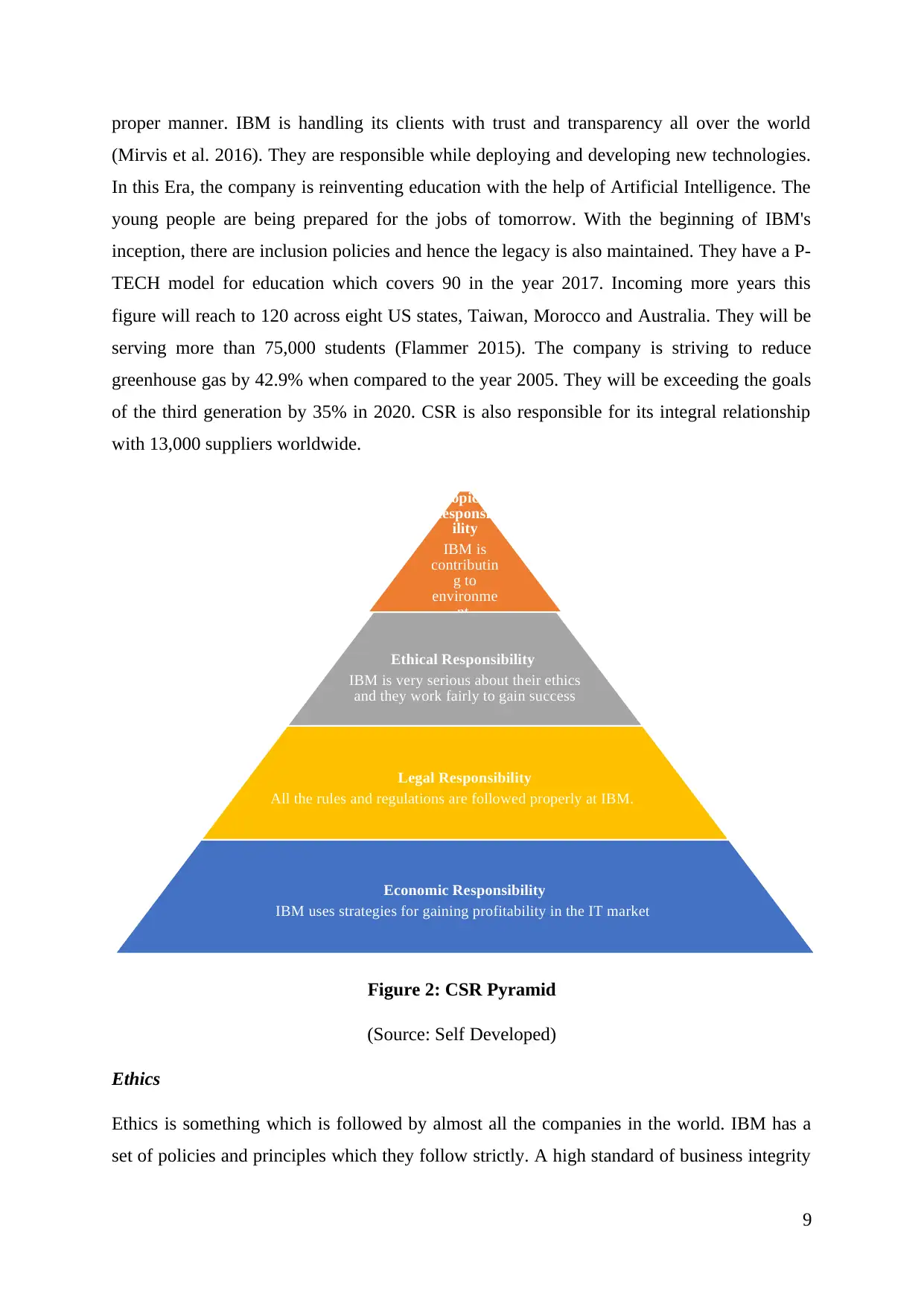
proper manner. IBM is handling its clients with trust and transparency all over the world
(Mirvis et al. 2016). They are responsible while deploying and developing new technologies.
In this Era, the company is reinventing education with the help of Artificial Intelligence. The
young people are being prepared for the jobs of tomorrow. With the beginning of IBM's
inception, there are inclusion policies and hence the legacy is also maintained. They have a P-
TECH model for education which covers 90 in the year 2017. Incoming more years this
figure will reach to 120 across eight US states, Taiwan, Morocco and Australia. They will be
serving more than 75,000 students (Flammer 2015). The company is striving to reduce
greenhouse gas by 42.9% when compared to the year 2005. They will be exceeding the goals
of the third generation by 35% in 2020. CSR is also responsible for its integral relationship
with 13,000 suppliers worldwide.
Figure 2: CSR Pyramid
(Source: Self Developed)
Ethics
Ethics is something which is followed by almost all the companies in the world. IBM has a
set of policies and principles which they follow strictly. A high standard of business integrity
9
Philanthr
opic
Responsib
ility
IBM is
contributin
g to
environme
nt,
communit
y and
educationEthical Responsibility
IBM is very serious about their ethics
and they work fairly to gain success
Legal Responsibility
All the rules and regulations are followed properly at IBM.
Economic Responsibility
IBM uses strategies for gaining profitability in the IT market
(Mirvis et al. 2016). They are responsible while deploying and developing new technologies.
In this Era, the company is reinventing education with the help of Artificial Intelligence. The
young people are being prepared for the jobs of tomorrow. With the beginning of IBM's
inception, there are inclusion policies and hence the legacy is also maintained. They have a P-
TECH model for education which covers 90 in the year 2017. Incoming more years this
figure will reach to 120 across eight US states, Taiwan, Morocco and Australia. They will be
serving more than 75,000 students (Flammer 2015). The company is striving to reduce
greenhouse gas by 42.9% when compared to the year 2005. They will be exceeding the goals
of the third generation by 35% in 2020. CSR is also responsible for its integral relationship
with 13,000 suppliers worldwide.
Figure 2: CSR Pyramid
(Source: Self Developed)
Ethics
Ethics is something which is followed by almost all the companies in the world. IBM has a
set of policies and principles which they follow strictly. A high standard of business integrity
9
Philanthr
opic
Responsib
ility
IBM is
contributin
g to
environme
nt,
communit
y and
educationEthical Responsibility
IBM is very serious about their ethics
and they work fairly to gain success
Legal Responsibility
All the rules and regulations are followed properly at IBM.
Economic Responsibility
IBM uses strategies for gaining profitability in the IT market
⊘ This is a preview!⊘
Do you want full access?
Subscribe today to unlock all pages.

Trusted by 1+ million students worldwide
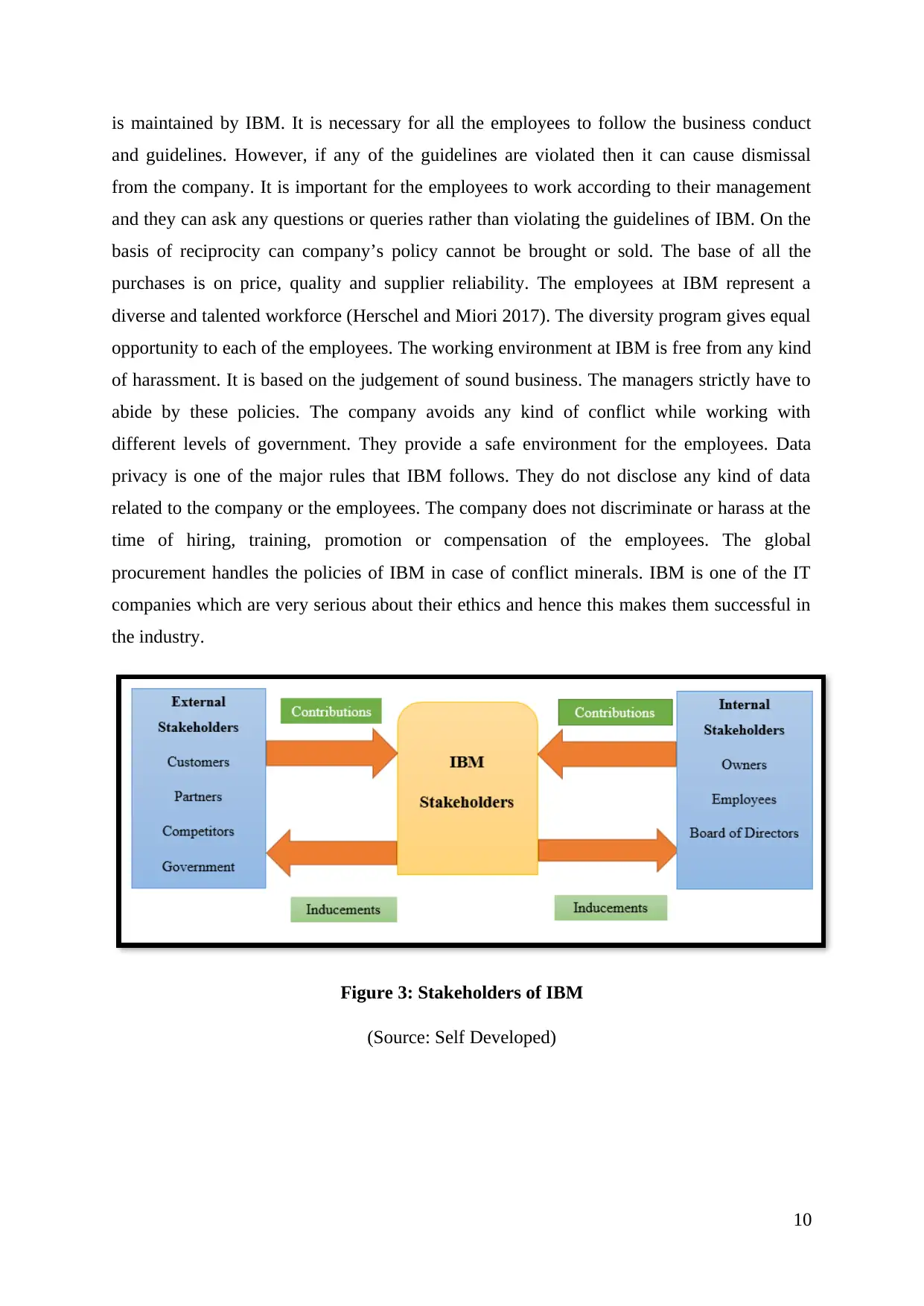
is maintained by IBM. It is necessary for all the employees to follow the business conduct
and guidelines. However, if any of the guidelines are violated then it can cause dismissal
from the company. It is important for the employees to work according to their management
and they can ask any questions or queries rather than violating the guidelines of IBM. On the
basis of reciprocity can company’s policy cannot be brought or sold. The base of all the
purchases is on price, quality and supplier reliability. The employees at IBM represent a
diverse and talented workforce (Herschel and Miori 2017). The diversity program gives equal
opportunity to each of the employees. The working environment at IBM is free from any kind
of harassment. It is based on the judgement of sound business. The managers strictly have to
abide by these policies. The company avoids any kind of conflict while working with
different levels of government. They provide a safe environment for the employees. Data
privacy is one of the major rules that IBM follows. They do not disclose any kind of data
related to the company or the employees. The company does not discriminate or harass at the
time of hiring, training, promotion or compensation of the employees. The global
procurement handles the policies of IBM in case of conflict minerals. IBM is one of the IT
companies which are very serious about their ethics and hence this makes them successful in
the industry.
Figure 3: Stakeholders of IBM
(Source: Self Developed)
10
and guidelines. However, if any of the guidelines are violated then it can cause dismissal
from the company. It is important for the employees to work according to their management
and they can ask any questions or queries rather than violating the guidelines of IBM. On the
basis of reciprocity can company’s policy cannot be brought or sold. The base of all the
purchases is on price, quality and supplier reliability. The employees at IBM represent a
diverse and talented workforce (Herschel and Miori 2017). The diversity program gives equal
opportunity to each of the employees. The working environment at IBM is free from any kind
of harassment. It is based on the judgement of sound business. The managers strictly have to
abide by these policies. The company avoids any kind of conflict while working with
different levels of government. They provide a safe environment for the employees. Data
privacy is one of the major rules that IBM follows. They do not disclose any kind of data
related to the company or the employees. The company does not discriminate or harass at the
time of hiring, training, promotion or compensation of the employees. The global
procurement handles the policies of IBM in case of conflict minerals. IBM is one of the IT
companies which are very serious about their ethics and hence this makes them successful in
the industry.
Figure 3: Stakeholders of IBM
(Source: Self Developed)
10
Paraphrase This Document
Need a fresh take? Get an instant paraphrase of this document with our AI Paraphraser
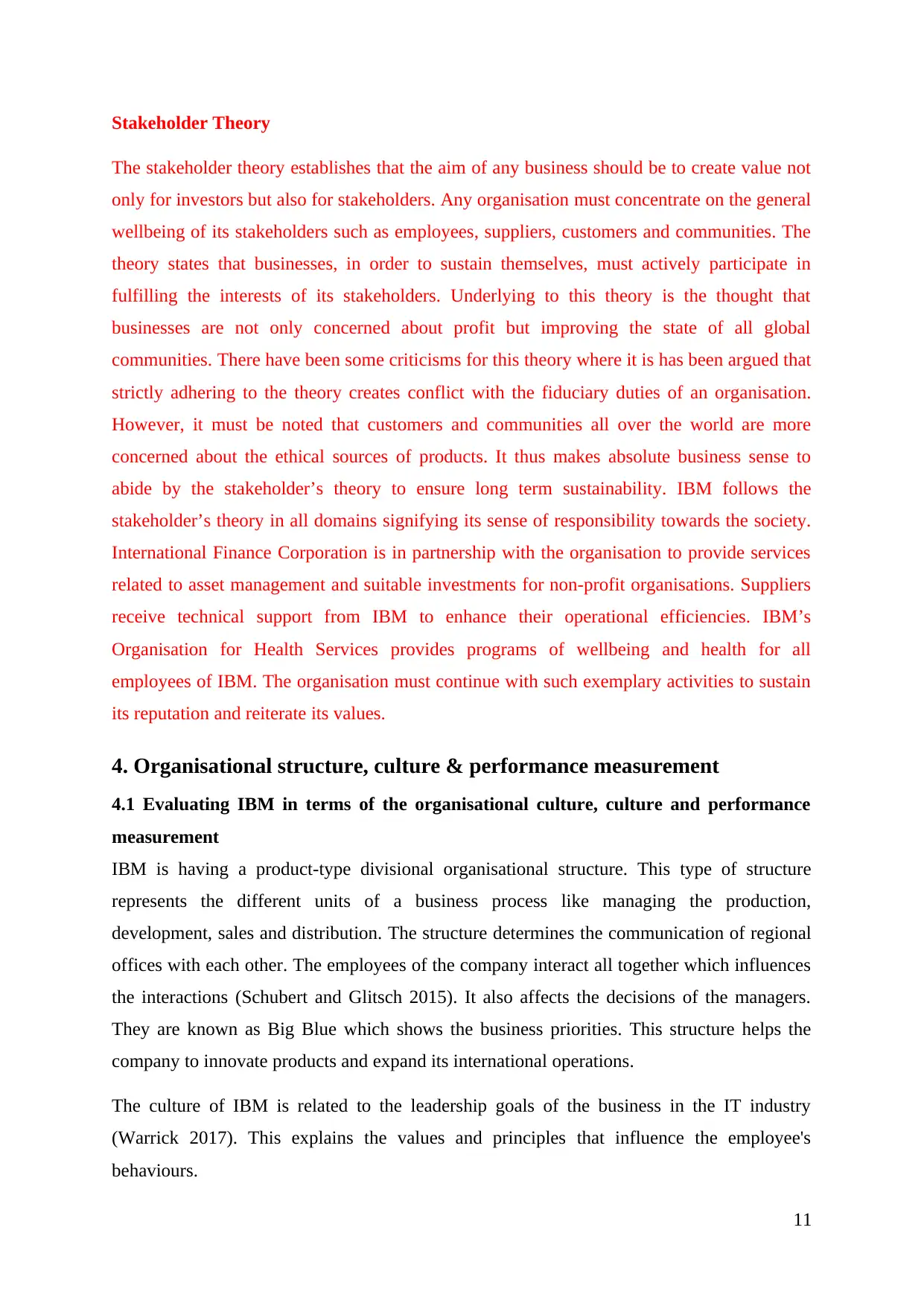
Stakeholder Theory
The stakeholder theory establishes that the aim of any business should be to create value not
only for investors but also for stakeholders. Any organisation must concentrate on the general
wellbeing of its stakeholders such as employees, suppliers, customers and communities. The
theory states that businesses, in order to sustain themselves, must actively participate in
fulfilling the interests of its stakeholders. Underlying to this theory is the thought that
businesses are not only concerned about profit but improving the state of all global
communities. There have been some criticisms for this theory where it is has been argued that
strictly adhering to the theory creates conflict with the fiduciary duties of an organisation.
However, it must be noted that customers and communities all over the world are more
concerned about the ethical sources of products. It thus makes absolute business sense to
abide by the stakeholder’s theory to ensure long term sustainability. IBM follows the
stakeholder’s theory in all domains signifying its sense of responsibility towards the society.
International Finance Corporation is in partnership with the organisation to provide services
related to asset management and suitable investments for non-profit organisations. Suppliers
receive technical support from IBM to enhance their operational efficiencies. IBM’s
Organisation for Health Services provides programs of wellbeing and health for all
employees of IBM. The organisation must continue with such exemplary activities to sustain
its reputation and reiterate its values.
4. Organisational structure, culture & performance measurement
4.1 Evaluating IBM in terms of the organisational culture, culture and performance
measurement
IBM is having a product-type divisional organisational structure. This type of structure
represents the different units of a business process like managing the production,
development, sales and distribution. The structure determines the communication of regional
offices with each other. The employees of the company interact all together which influences
the interactions (Schubert and Glitsch 2015). It also affects the decisions of the managers.
They are known as Big Blue which shows the business priorities. This structure helps the
company to innovate products and expand its international operations.
The culture of IBM is related to the leadership goals of the business in the IT industry
(Warrick 2017). This explains the values and principles that influence the employee's
behaviours.
11
The stakeholder theory establishes that the aim of any business should be to create value not
only for investors but also for stakeholders. Any organisation must concentrate on the general
wellbeing of its stakeholders such as employees, suppliers, customers and communities. The
theory states that businesses, in order to sustain themselves, must actively participate in
fulfilling the interests of its stakeholders. Underlying to this theory is the thought that
businesses are not only concerned about profit but improving the state of all global
communities. There have been some criticisms for this theory where it is has been argued that
strictly adhering to the theory creates conflict with the fiduciary duties of an organisation.
However, it must be noted that customers and communities all over the world are more
concerned about the ethical sources of products. It thus makes absolute business sense to
abide by the stakeholder’s theory to ensure long term sustainability. IBM follows the
stakeholder’s theory in all domains signifying its sense of responsibility towards the society.
International Finance Corporation is in partnership with the organisation to provide services
related to asset management and suitable investments for non-profit organisations. Suppliers
receive technical support from IBM to enhance their operational efficiencies. IBM’s
Organisation for Health Services provides programs of wellbeing and health for all
employees of IBM. The organisation must continue with such exemplary activities to sustain
its reputation and reiterate its values.
4. Organisational structure, culture & performance measurement
4.1 Evaluating IBM in terms of the organisational culture, culture and performance
measurement
IBM is having a product-type divisional organisational structure. This type of structure
represents the different units of a business process like managing the production,
development, sales and distribution. The structure determines the communication of regional
offices with each other. The employees of the company interact all together which influences
the interactions (Schubert and Glitsch 2015). It also affects the decisions of the managers.
They are known as Big Blue which shows the business priorities. This structure helps the
company to innovate products and expand its international operations.
The culture of IBM is related to the leadership goals of the business in the IT industry
(Warrick 2017). This explains the values and principles that influence the employee's
behaviours.
11
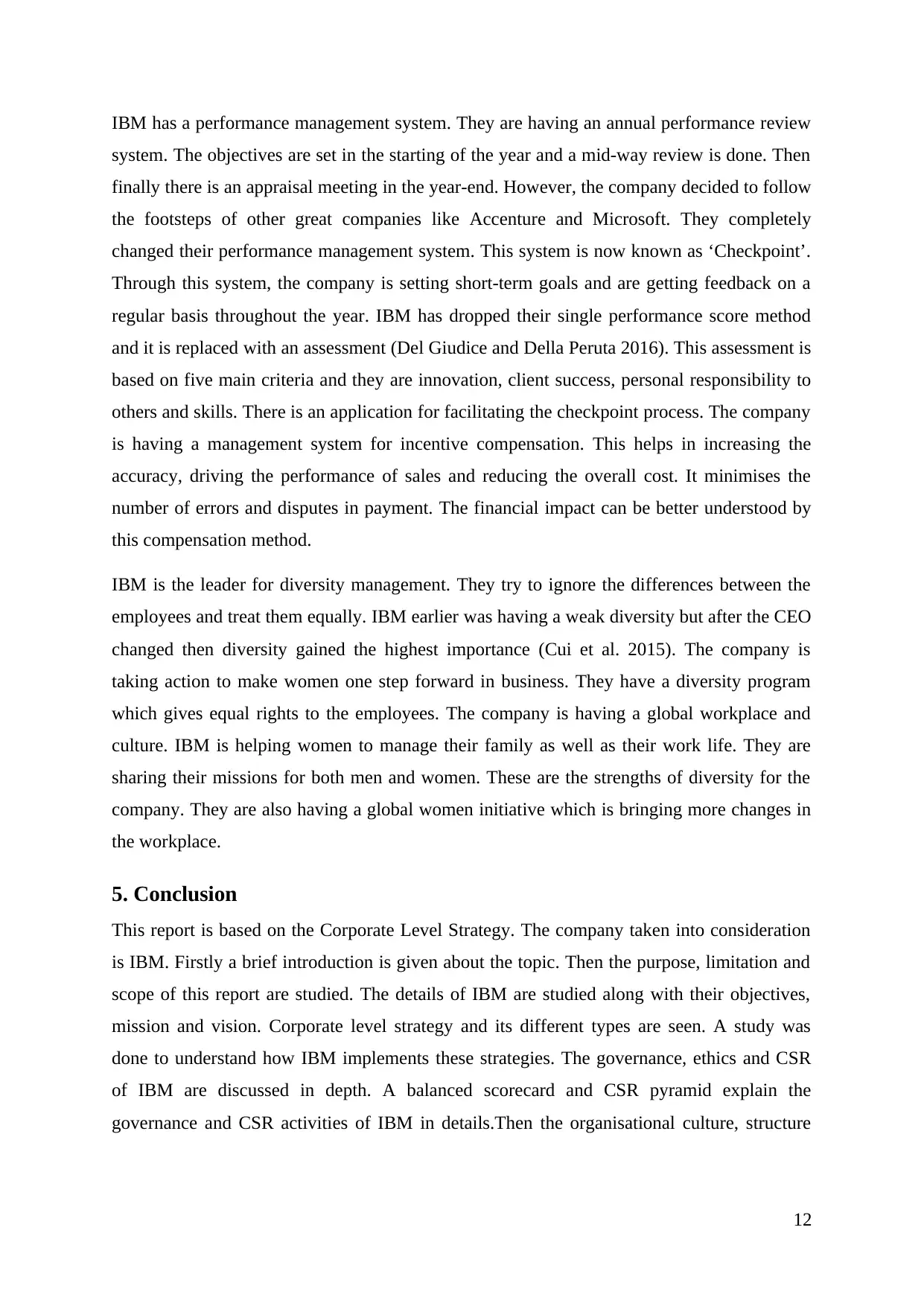
IBM has a performance management system. They are having an annual performance review
system. The objectives are set in the starting of the year and a mid-way review is done. Then
finally there is an appraisal meeting in the year-end. However, the company decided to follow
the footsteps of other great companies like Accenture and Microsoft. They completely
changed their performance management system. This system is now known as ‘Checkpoint’.
Through this system, the company is setting short-term goals and are getting feedback on a
regular basis throughout the year. IBM has dropped their single performance score method
and it is replaced with an assessment (Del Giudice and Della Peruta 2016). This assessment is
based on five main criteria and they are innovation, client success, personal responsibility to
others and skills. There is an application for facilitating the checkpoint process. The company
is having a management system for incentive compensation. This helps in increasing the
accuracy, driving the performance of sales and reducing the overall cost. It minimises the
number of errors and disputes in payment. The financial impact can be better understood by
this compensation method.
IBM is the leader for diversity management. They try to ignore the differences between the
employees and treat them equally. IBM earlier was having a weak diversity but after the CEO
changed then diversity gained the highest importance (Cui et al. 2015). The company is
taking action to make women one step forward in business. They have a diversity program
which gives equal rights to the employees. The company is having a global workplace and
culture. IBM is helping women to manage their family as well as their work life. They are
sharing their missions for both men and women. These are the strengths of diversity for the
company. They are also having a global women initiative which is bringing more changes in
the workplace.
5. Conclusion
This report is based on the Corporate Level Strategy. The company taken into consideration
is IBM. Firstly a brief introduction is given about the topic. Then the purpose, limitation and
scope of this report are studied. The details of IBM are studied along with their objectives,
mission and vision. Corporate level strategy and its different types are seen. A study was
done to understand how IBM implements these strategies. The governance, ethics and CSR
of IBM are discussed in depth. A balanced scorecard and CSR pyramid explain the
governance and CSR activities of IBM in details.Then the organisational culture, structure
12
system. The objectives are set in the starting of the year and a mid-way review is done. Then
finally there is an appraisal meeting in the year-end. However, the company decided to follow
the footsteps of other great companies like Accenture and Microsoft. They completely
changed their performance management system. This system is now known as ‘Checkpoint’.
Through this system, the company is setting short-term goals and are getting feedback on a
regular basis throughout the year. IBM has dropped their single performance score method
and it is replaced with an assessment (Del Giudice and Della Peruta 2016). This assessment is
based on five main criteria and they are innovation, client success, personal responsibility to
others and skills. There is an application for facilitating the checkpoint process. The company
is having a management system for incentive compensation. This helps in increasing the
accuracy, driving the performance of sales and reducing the overall cost. It minimises the
number of errors and disputes in payment. The financial impact can be better understood by
this compensation method.
IBM is the leader for diversity management. They try to ignore the differences between the
employees and treat them equally. IBM earlier was having a weak diversity but after the CEO
changed then diversity gained the highest importance (Cui et al. 2015). The company is
taking action to make women one step forward in business. They have a diversity program
which gives equal rights to the employees. The company is having a global workplace and
culture. IBM is helping women to manage their family as well as their work life. They are
sharing their missions for both men and women. These are the strengths of diversity for the
company. They are also having a global women initiative which is bringing more changes in
the workplace.
5. Conclusion
This report is based on the Corporate Level Strategy. The company taken into consideration
is IBM. Firstly a brief introduction is given about the topic. Then the purpose, limitation and
scope of this report are studied. The details of IBM are studied along with their objectives,
mission and vision. Corporate level strategy and its different types are seen. A study was
done to understand how IBM implements these strategies. The governance, ethics and CSR
of IBM are discussed in depth. A balanced scorecard and CSR pyramid explain the
governance and CSR activities of IBM in details.Then the organisational culture, structure
12
⊘ This is a preview!⊘
Do you want full access?
Subscribe today to unlock all pages.

Trusted by 1+ million students worldwide
1 out of 19
Related Documents
Your All-in-One AI-Powered Toolkit for Academic Success.
+13062052269
info@desklib.com
Available 24*7 on WhatsApp / Email
![[object Object]](/_next/static/media/star-bottom.7253800d.svg)
Unlock your academic potential
Copyright © 2020–2025 A2Z Services. All Rights Reserved. Developed and managed by ZUCOL.




